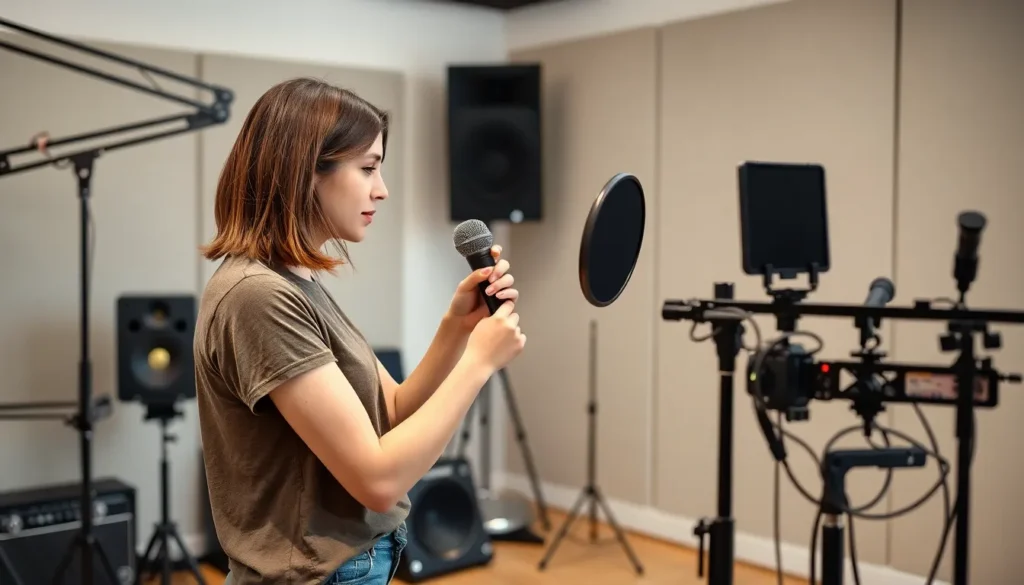Table of Contents
ToggleWhen it comes to capturing crystal-clear audio, lavalier mics are the unsung heroes of the sound world. These tiny powerhouses can turn a casual chat into a professional podcast and make even the most mundane presentations sound like a TED Talk. If you’ve ever wondered how to elevate your audio game without looking like you’re auditioning for a spy movie, you’re in the right place.
Overview of Lavalier Mic Setups
Lavalier microphone setups typically consist of the microphone itself, a power supply, and a transmitter. These components work together to capture and transmit audio effectively. For optimal results, positioning the microphone close to the sound source enhances audio clarity.
Many setups utilize wireless transmitters connected to cameras or audio recorders. Wireless options eliminate cable clutter while providing mobility. Some users prefer wired lavalier microphones, especially in controlled environments, as they often deliver more reliable audio quality.
Various types of lavalier microphones exist, including omnidirectional and directional models. Omnidirectional mics capture sound from all directions, making them suitable for interviews or group discussions. Directional mics focus on specific sound sources, which is beneficial in noisy environments.
Setup configurations can differ based on the intended use. For interviews, placing microphones on the interviewee’s clothing ensures clear audio capture. When recording presentations, positioning multiple mics allows for a smooth flow of conversation without interruptions.
Battery choice impacts setup reliability. Rechargeable batteries reduce waste and provide long operating times, while disposable batteries offer convenience for quick replacements. Regular testing of batteries and equipment ensures optimal performance during recordings.
Connecting lavalier mics to smartphones and laptops requires compatible adapters. Users should check compatibility with their devices to avoid connection issues. Configuring audio levels and panning can significantly improve audio quality, allowing for a more polished final product.
Exploring different brands and models helps users find the perfect fit for their needs. Evaluating features like frequency response, sensitivity, and build quality aids in making informed decisions. Investing in quality equipment ultimately enhances the overall audio experience.
Types of Lavalier Microphones

Lavalier microphones come in two primary types: wired and wireless, each serving specific needs and preferences.
Wired Lavalier Microphones
Wired lavalier microphones connect directly to recording devices using an audio cable. These mics offer reliability in controlled environments where mobility isn’t a priority. Many professionals favor wired options for their minimal audio latency and consistent power supply. Cables can limit movement but often deliver higher sound quality without interference issues seen in wireless models. They’re ideal for interviews and presentations where audio fidelity ranks high. Users must be cautious of cable lengths and placement to prevent noise from movement or tangling.
Wireless Lavalier Microphones
Wireless lavalier microphones use radio frequencies to transmit audio signals, allowing greater freedom of movement. These mics feature a transmitter attached to the sound source and a receiver connected to the recording device. Mobility enhances comfort during interviews and presentations, making them popular in dynamic settings. Battery life plays a crucial role, with some models offering extended durations suitable for longer events. Users should consider range specifications, ensuring reliable signal strength within the intended environment. Overall, wireless options deliver flexibility without sacrificing audio quality when properly configured.
Essential Gear for Lavalier Mic Setups
Lavalier mic setups require specific gear to ensure optimal performance. Selecting appropriate components enhances audio quality and reliability.
Recording Devices
Common recording devices include cameras, smartphones, and audio recorders. Each device should offer compatibility with the chosen lavalier microphone. Cameras often feature a 3.5mm input, while smartphones may need an adapter. Digital audio recorders provide high-quality sound for projects that require professional-grade audio. Understanding the specifications of recording devices ensures effective audio capture and seamless setup.
Accessories and Enhancements
Useful accessories enhance the overall lavalier mic experience. Windshields reduce unwanted noise from wind, making them vital for outdoor recording. Clip holders securely position microphones, ensuring they remain unobtrusive during use. Additionally, extension cables allow for greater flexibility in mic placement. The use of battery packs prolongs operating time, which is essential for longer sessions. Prioritizing these accessories facilitates improved sound quality and usability in various environments.
Tips for Setting Up Lavalier Mics
Setting up lavalier microphones correctly ensures optimal audio quality. Effective techniques for placement and troubleshooting enhance overall performance.
Placement Techniques
Positioning the lavalier mic close to the sound source significantly improves audio clarity. Clip the microphone one to two inches below the speaker’s chin for optimal capture. Adjust the angle of the mic to face the speaker’s mouth directly, which reduces background noise. When dealing with multiple speakers, assign each person a distinct mic to avoid audio confusion. Secure the lavalier mic to clothing using clips for stability, preventing unwanted movement during recording. Using windshields is advantageous for outdoor settings, as these minimize wind interference.
Troubleshooting Common Issues
Addressing common problems can enhance audio experiences. Check battery levels frequently, especially for wireless mics, to avoid unexpected outages. Ensure connectivity; loose cables can lead to poor audio quality. When experiencing distortion, lower the input gain to prevent overloading the mic. If feedback occurs, reposition the microphone away from speakers or other audio sources. Monitor audio levels continuously during recording to catch issues early. Having extra batteries and a backup mic provides peace of mind during critical recordings.
Investing in a quality lavalier mic setup can significantly elevate audio performance in various recording scenarios. By understanding the nuances of different microphone types and configurations, users can tailor their setups to suit specific needs. Whether opting for wired or wireless solutions, attention to detail in placement and compatibility ensures optimal sound capture.
Incorporating essential accessories and troubleshooting techniques further enhances the overall experience. With the right equipment and knowledge, achieving professional-level audio is within reach. Embracing these tools not only improves clarity but also enhances the overall impact of any project.







